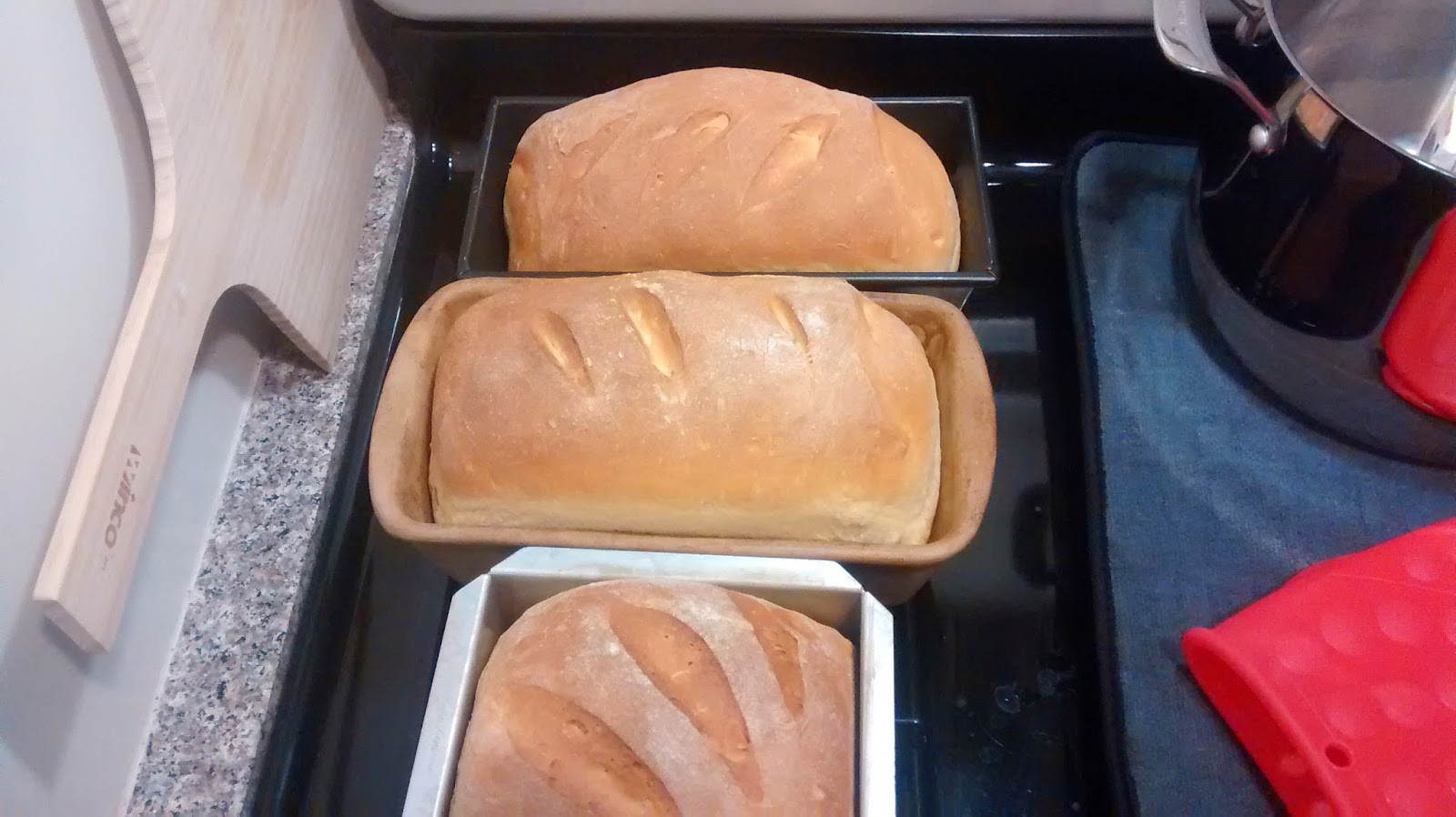I have been on the search for a great White Sandwich Bread recipe and I then found
this recipe. Like like this recipe as well because I felt like the lady knows her bread baking. She is very informative. My family and I are in love with the results. Went through two loafs in three days (family of three). We froze the other loaf for later. I apologize for not taking many pictures of each step I just forgot.
Country White Bread
Makes 3 loaves, about 1½ pounds each
4 cups (1 lb, 4 oz) all-purpose flour
1½ Tablespoons* (17 grams) instant yeast
2 Tablespoons granulated or brown sugar or honey
2 Tablespoons melted butter
4 cups (2 pounds) warm milk (about 85° F)
About 6 cups (1 lb, 13 oz ) bread (high gluten) flour (or all-purpose flour)
1½ Tablespoons (22 grams) salt
* To bake an even better loaf, you can reduce the amount of yeast to 1 Tablespoon (or even less). This will make your dough rise more slowly, so you'll just need to increase the rising times. You can reduce the yeast in pretty much any bread recipe; a lot of bakers go by the formula, 'half the yeast and double the rising time.'
Step 1: The First Rise
In a very large bowl, stir together the all-purpose flour, yeast, and sugar (I use a stand mixer). Make a small well in the middle of the flour mixture and pour in the butter and the milk.
Mix well, then continue to stir vigorously, slowly adding 1 cup of the bread flour at a time, until you've added about 4 cups and have a sticky, shaggy dough; this should take several minutes.
Cover the bowl with a damp tea towel and let it rest for 20 minutes.
Step 2: The Second Rise
Add the salt and 1 more cup of bread flour and stir it in as best you can. Add another cup of bread flour if the dough is still too sticky to knead. Turn the dough out onto a floured work surface and knead it with floured hands until the dough is soft and smooth, about 8 to 10 minutes (I just keep it in the stand mixer and let it do all the work).
As you're kneading, sprinkle a little more flour at a time as needed to keep it from sticking to your hands or the work surface. You want the dough to be as soft as possible without being sticky; you may not need the entire six cups of bread flour, or you may need a little extra.
Sprinkle flour in the dough bowl, place the dough in it, liberally dust it with flour, and cover it with a damp tea towel. Or you can let it rise in a straight sided, food grade plastic container with a snap-on lid, which is what I do now. Mark the spot on the container that the dough will reach when it has doubled in volume.
Set the dough somewhere that is preferably between 70°F and 75°F until it has doubled in size, about 60 to 75 minutes. Ideally, the dough itself should be between 70°F and 75°F. It's fine if your dough is cooler; it'll just take longer to rise and will end up even tastier.
Step 3: The Third Rise
When the dough is ready to be shaped, you should be able to push a floured finger deep into it and leave an indentation that doesn't spring back. Unless your dough is rising in a straight sided container, it can be difficult to judge whether it has doubled in size, which is the guideline most recipes use. I find the finger poking method to be more reliable.
Turn the risen dough out onto a lightly floured work surface, flattening gently with your hands to break up any large air bubbles. Divide the dough into three equal pieces.
If you're using a baking stone, put it in the cold oven now and heat the oven to 375°.
Shape the dough into loaves. Place the loaves seam side down in greased loaf pans and dust them with flour. I like my sandwich breads to be tall, so I use 8-inch loaf pans.
Cover the loaves with a damp tea towel and let them rise until the dough springs back just a little when you gently poke it with a floured finger, about 40 to 60 minutes.
Bake at 375° for 35 minutes, or until the loaves are golden brown and the bottoms sound hollow if tapped (you need to carefully take a loaf out of the pan to check this). Remove the finished loaves immediately from the pans and let them cool on a wire rack. The bread will continue to bake inside while it's cooling, so try to wait at least 40 minutes before cutting into a loaf.
Store at room temperature or freeze in zipper freezer bags. Make sure the loaves are completely cooled before sealing in bags.
Note I copied the original recipes instructions because I felt that she did an amazing job explaining












